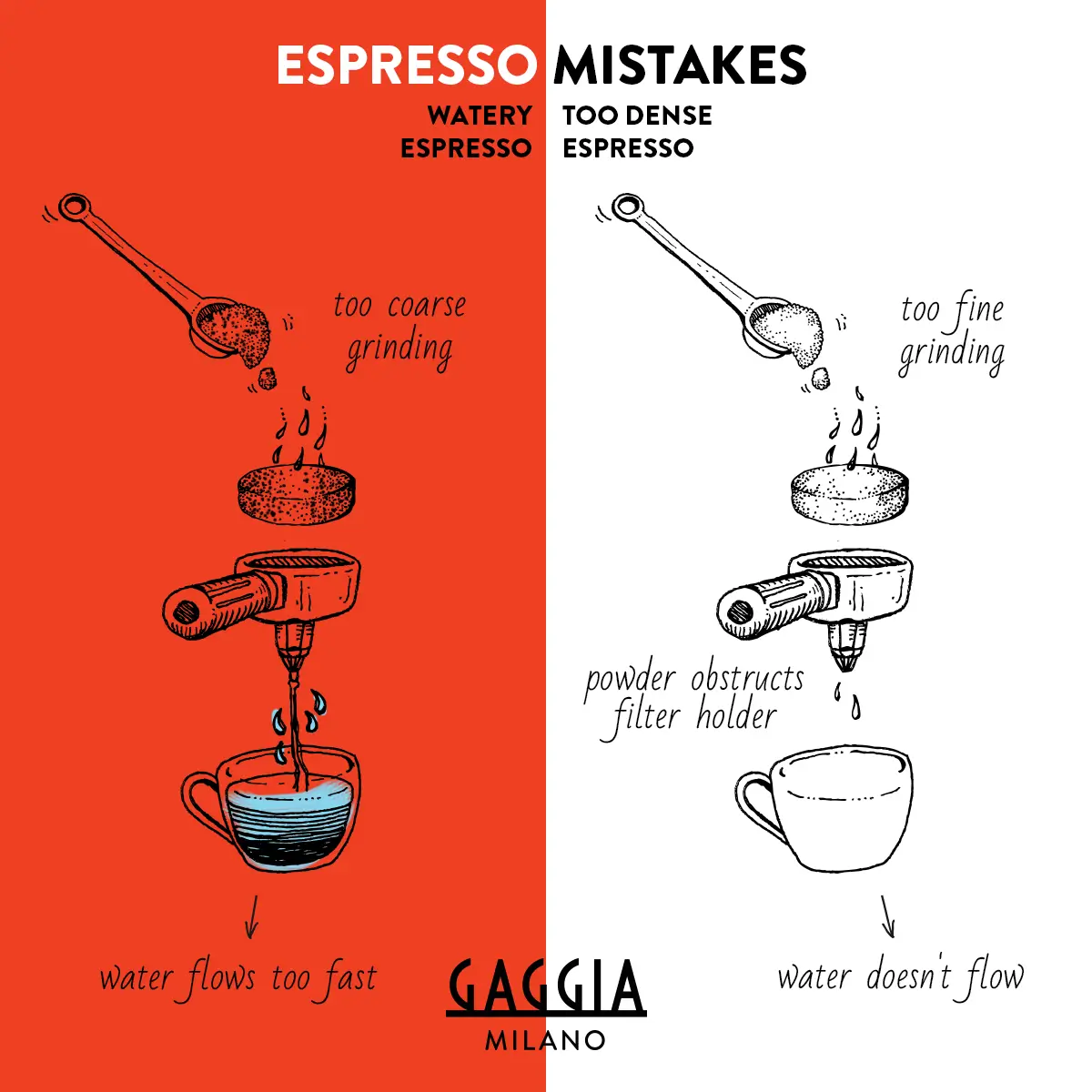A watery espresso often results from an incorrect grind size or insufficient tamping. Both factors affect extraction and flavor.
Espresso lovers know that achieving the perfect shot involves precision. A grind that is too fine or too coarse can ruin the experience. Incorrect grind size affects water flow, leading to under or over-extraction. Another crucial factor is tamping pressure. Insufficient tamping creates channels for water to flow quickly, resulting in a weak, watery shot.
Consistency in both grind size and tamping ensures balanced extraction. Using fresh, high-quality beans also plays a significant role. Paying attention to these elements can transform your espresso from watery to rich and flavorful. For a consistently great shot, invest time in mastering these basics.
The Essence Of Espresso
Espresso, a small yet powerful coffee, is cherished worldwide. Its strong flavor and rich aroma make it unique. But a watery espresso can disappoint.
Why is My Espresso Watery? Troubleshooting Your Shot
Is your espresso lacking body and flavor? Let’s dive into the common culprits behind watery espresso, from grind size and coffee freshness to equipment maintenance. We’ll help you achieve a rich, full-bodied shot every time.
Characteristics Of The Perfect Shot
A perfect espresso shot has a bold flavor. The texture should be creamy, not watery. Its crema, the golden layer on top, is essential. The crema adds both taste and aroma.
- Bold flavor
- Creamy texture
- Golden crema
Each element needs balance. Too much or too little of any part affects the espresso. The grind size, water temperature, and pressure are crucial.
Common Misconceptions
Many think watery espresso is due to bad beans. While beans matter, other factors play a role too.
| Misconception | Reality |
|---|---|
| Bad Beans | Grind size or machine settings |
| Too Much Water | Pressure or tamping issues |
Using fresh beans helps, but check your grind size. A fine grind ensures a rich shot. Check your machine’s pressure settings too.
Grind Size And Its Impact
One common reason for watery espresso is the grind size. The grind size affects how water extracts flavors from the coffee. If the grind size is incorrect, the espresso will taste weak or watery.
Finding The Right Grind Consistency
The right grind consistency is crucial for a good espresso. Fine grounds allow for better extraction. Coarse grounds can cause under-extraction, leading to a watery taste. A good espresso grind should feel like powdered sugar. Use a burr grinder for more consistent results.
Adjusting Your Grinder Settings
Adjusting your grinder settings can help achieve the perfect grind size. Here are some steps:
- Start with a medium-fine setting on your grinder.
- Test your espresso shot.
- If it’s watery, adjust to a finer setting.
- If it’s bitter, adjust to a coarser setting.
Keep adjusting until you find the right balance. Each grinder is different, so experiment to find your perfect setting. A good grind size can make a huge difference in your espresso quality.
Here’s a quick reference table for grind settings:
| Grind Setting | Result |
|---|---|
| Too Coarse | Watery Espresso |
| Too Fine | Bitter Espresso |
| Just Right | Perfect Espresso |
Remember, even small changes can impact your espresso. Adjust slowly and test each shot. This will help you achieve the best results.
Measuring The Coffee
Espresso lovers often face the issue of watery espresso. One major culprit could be incorrect coffee measurement. By getting the measurement right, you can improve your espresso’s quality. Let’s explore the key aspects of measuring the coffee for the perfect espresso.
The Importance Of Scale
Using a scale is crucial for precise coffee measurement. A scale ensures you use the exact amount of coffee each time. Consistency in measurement leads to consistent flavor and strength.
Scales are more accurate than scoops or spoons. They help avoid guesswork and ensure precise dosing. Investing in a good scale can make a big difference in your espresso quality.
Ideal Coffee-to-water Ratio
The ideal coffee-to-water ratio is essential for a balanced espresso. A common ratio is 1:2. This means for every gram of coffee, you use two grams of water.
| Grams of Coffee | Grams of Water |
|---|---|
| 18g | 36g |
| 20g | 40g |
| 22g | 44g |
Sticking to this ratio helps achieve a rich, flavorful espresso. Deviating from the ratio can lead to watery or overly strong espresso. Use a scale to maintain this balance.
Remember, the ratio can vary based on personal preference. Start with the 1:2 ratio and adjust as needed. Finding your perfect ratio will enhance your espresso experience.
Tamping Techniques
Wondering why your espresso is watery? It might be your tamping techniques. Tamping affects the water flow through coffee grounds. Proper tamping ensures a rich and creamy espresso. Let’s dive into the details of tamping techniques.
The Role Of Pressure In Tamping
Pressure is crucial in tamping. It compresses the coffee grounds evenly. Too much or too little pressure can ruin your espresso. Aim for around 30 pounds of pressure. This ensures a balanced extraction.
Use a consistent force each time you tamp. This helps maintain uniformity in your espresso shots. Inconsistent pressure leads to uneven extraction. Uneven extraction results in a watery espresso.
Credit: www.facebook.com
Common Tamping Mistakes
Many make common tamping mistakes. These mistakes affect the espresso quality. Here are some of them:
- Uneven Tamping: Pressing the tamper at an angle. This creates uneven pressure.
- Too Much Pressure: Excessive force compacts the grounds too tightly. Water struggles to pass through.
- Too Little Pressure: Not enough force leaves the grounds loose. Water flows too quickly, causing a watery espresso.
Avoid these mistakes for better espresso. Practice makes perfect. Consistency is key in tamping techniques.
| Common Mistakes | Impact on Espresso |
|---|---|
| Uneven Tamping | This leads to uneven extraction |
| Too Much Pressure | Creates over-extracted, bitter espresso |
| Too Little Pressure | Results in under-extracted, watery espresso |
Remember to use a tamper that fits your portafilter. A poor fit can also lead to uneven tamping. Use the right tools for the best results.
Water Temperature And Pressure
One of the common issues with home espresso machines is a watery espresso. Water temperature and pressure play a critical role in espresso extraction. Incorrect settings can lead to weak, watery shots.
Optimal Conditions For Extraction
For a perfect espresso, the water temperature should be between 195°F and 205°F (90°C to 96°C). This range helps extract the coffee’s oils and flavors. A lower temperature may not extract enough, making the espresso watery.
Pressure is equally important. The ideal pressure for espresso is 9 bars. If the pressure is too low, the water will flow too quickly through the coffee grounds. This results in under-extraction and a watery espresso.
Troubleshooting Temperature Issues
First, use a thermometer to check your machine’s water temperature. If it’s below 195°F (90°C), adjust the settings if possible. Some machines have a built-in temperature control.
If your machine lacks this feature, consider upgrading to one with better temperature control. Ensure your machine is properly preheated before brewing. Run a shot of hot water through the machine to warm it up.
Next, check the pressure settings. Make sure it reads around 9 bars. If the pressure is low, consult your machine’s manual for adjustments.
| Aspect | Optimal Range | Action |
|---|---|---|
| Temperature | 195°F to 205°F (90°C to 96°C) | Adjust settings or upgrade the machine |
| Pressure | 9 bars | Check and adjust |
Maintaining the right water temperature and pressure ensures a rich, flavorful espresso. Proper settings prevent watery shots and enhance the coffee experience.
Espresso Machine Maintenance
Maintaining your espresso machine is crucial for a great cup. A well-maintained machine ensures consistent quality and taste. Neglecting maintenance can lead to watery espresso, affecting your coffee experience.
Routine Cleaning For Peak Performance
Regular cleaning keeps your espresso machine in top shape. Clean the machine daily to remove coffee oils and residues. Use a damp cloth and a steam wand to wipe the exterior. Every week, backflush the machine to clear the group head and valves.
- Clean the drip tray and water reservoir.
- Descale the machine monthly to remove mineral buildup.
- Replace the water filter regularly to ensure pure water.
Use a cleaning tablet to deep clean every few months. Follow the manufacturer’s instructions for the best results.
Signs Your Machine Needs Attention
Recognizing the signs of a machine needing maintenance is vital. Watch out for these indicators:
| Sign | Description |
|---|---|
| Watery Espresso | Your espresso tastes weak and watery. |
| Slow Extraction | Espresso takes longer to pour than usual. |
| Unusual Noises | The machine makes odd sounds during operation. |
| Temperature Fluctuations | Espresso is too hot or too cold. |
Address these signs quickly to avoid further damage. Regular maintenance prevents most issues and ensures a perfect espresso every time.
Beans’ Quality And Freshness
Is your espresso watery? The quality and freshness of your beans could be the issue. Fresh, high-quality beans are crucial for a rich and flavorful espresso.
Selecting The Right Beans
Choosing the right beans is essential. Here are some tips:
- Origin: Different regions produce different flavors. Try beans from various origins to find your favorite.
- Roast Level: Medium to dark roasts are best for espresso. They have a richer flavor.
- Freshness: Check the roast date. Beans should be used within two weeks of roasting.
Storage Tips To Preserve Freshness
Proper storage keeps your beans fresh. Follow these tips:
- Airtight Containers: Use containers that seal tightly. This prevents air from degrading the beans.
- Cool, Dark Place: Store beans in a cool, dark place. Light and heat can spoil them.
- Grind as Needed: Grind your beans just before brewing. This ensures maximum flavor.
Here is a quick table for easy reference:
| Tip | Reason |
|---|---|
| Use Airtight Containers | Prevents air exposure |
| Store in a Cool, Dark Place | Protects from light and heat |
| Grind as Needed | Keeps beans fresh |
Barista Skills And Techniques
Perfecting the art of espresso-making requires more than just good equipment. Barista skills and techniques play a crucial role in achieving that perfect shot. If your espresso is watery, it might be due to some overlooked aspects of your technique. This section will cover essential skills every barista should master and the importance of continuous learning and practice.
Mastering The Art Of Espresso Making
Mastering the art of espresso making involves several key steps:
- Grind size: The grind size should be fine but not too fine.
- Tamping: Apply consistent pressure to ensure even extraction.
- Water temperature: Keep it between 195°F and 205°F.
- Extraction time: Aim for 25-30 seconds.
Each of these steps impacts the quality of your espresso. Incorrect grind size can lead to under-extraction, making your espresso watery. Uneven tamping can also cause channeling, resulting in a weak shot. Ensure your water temperature is in the right range. Too hot or too cold water can ruin the extraction process. Finally, monitor the extraction time. A shot pulled too quickly often lacks depth and richness.
Continuous Learning And Practice
Even experienced baristas need to engage in continuous learning and practice. The coffee world is ever-evolving, with new techniques and tools emerging regularly. Here are some tips to stay updated:
- Workshops: Attend barista workshops to learn new skills.
- Online courses: Many platforms offer courses on advanced techniques.
- Practice: Regular practice helps refine your skills.
- Feedback: Seek feedback from experienced baristas.
By keeping yourself updated and practicing regularly, you can improve your technique. This will help you avoid common mistakes that lead to watery espresso. Remember, even small adjustments can make a big difference in the final cup.
Troubleshooting Common Issues
Is your espresso turning out watery? This can be frustrating. Understanding the common issues can help you fix it. Let’s dive into diagnosing and solving the problem.
Diagnosing Watery Espresso
First, identify why your espresso is watery. Check the grind size, coffee dose, and tamping pressure.
| Issue | Possible Cause |
|---|---|
| Grind Size | Too coarse |
| Coffee Dose | Too low |
| Tamping Pressure | Too light |
Step-by-step Solutions
Follow these steps to fix your watery espresso:
- Adjust the Grind Size: Use a finer grind. This slows water flow and extracts more flavor.
- Increase Coffee Dose: Add more coffee to the portafilter. Aim for 18-20 grams.
- Proper Tamping: Apply firm pressure while tamping. Ensure an even surface.
Check your espresso machine settings. Ensure the temperature is correct. A low temperature can cause watery espresso.
Lastly, inspect your machine’s water pressure. Low pressure can lead to under-extraction. Adjust settings if needed.
Frequently Asked Questions
How Do You Fix Watery Espresso?
To fix watery espresso, use finer coffee grounds, increase the dose, and tamp more firmly. Ensure proper brewing temperature and pressure.
Why Is There So Much Water In My Espresso?
Too much water in your espresso can be due to incorrect grind size, insufficient coffee grounds, or improper tamping. Use finer grind and proper tamping pressure.
Why Is My Espresso Cup Watery?
Your espresso cup may be watery due to incorrect grind size, insufficient coffee grounds, or short extraction time. Use finer grind and proper tamping for better results.
Why Does My Espresso Always Taste Watery?
Your espresso may taste watery due to under-extraction. Use finer coffee grounds and ensure proper tamping. Also, check the water temperature and shot timing.
Conclusion
Achieving the perfect espresso requires attention to detail. Ensure your grind size, tamping pressure, and extraction time are correct. Regularly clean your machine to avoid buildup. By following these steps, you can enjoy a rich, flavorful espresso. Remember, practice makes perfect.
Keep experimenting until you find the ideal balance for your taste.



